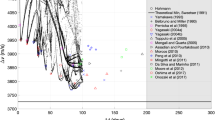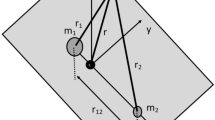Abstract
This contribution deals with fast Earth–Moon transfers with ballistic capture in the patched three-body model. We compute ensembles of preliminary solutions using a model that takes into account the relative inclination of the orbital planes of the primaries. The ballistic capture orbits around the Moon are obtained relying on the hyperbolic invariant structures associated to the collinear Lagrangian points of the Earth–Moon system, and the Sun–Earth system portion of the transfers are quasi-periodic orbits obtained by a genetic algorithm. The trajectories are designed to be good initial guesses to search optimal cost-efficient short-time Earth–Moon transfers with ballistic capture in more realistic models.









Similar content being viewed by others
References
Anderson, R., Parker, J.: Survey of ballistic transfers to the lunar surface. J. Guid. Control Dyn. 35(4), 1256–1267 (2012)
Belbruno, E., Miller, J.: A ballistic lunar capture trajectory for the Japanese spacecraft hiten. Tech. Rep. 312/90.4-1731-EAB, Jet Propulsion Laboratory (1990)
Belbruno, E., Miller, J.: Sun-perturbed Earth-to-Moon transfers with ballistic capture. J. Guid. Control Dyn. 16(4), 770–775 (1993)
Chung, M., Hatch, S., Kangas, J., Long, S., Roncoli, R., Sweetser, T.: Trans-lunar cruise trajectory design of GRAIL (Gravity Recovery and Interior Laboratory) mission. In: AIAA/AAS Astrodynamics Specialist Conference (2010). AIAA, Paper ID AIAA 2010-8384
Deb, K., Pratap, A., Agarwal, S., Meyarivan, T.: A fast and elitist multiobjective genetic algorithm: NSGA-II. IEEE Trans. Evol. Comput. 6, 182–197 (2002)
Folta, D.C., Woodard, M., Howell, K., Patterson, C., Wayne, S.: Applications of multi-body dynamical environments: the ARTEMIS transfer trajectory design. Acta Astronaut. 73, 237–249 (2012)
Folta, D.C., Pavlak, T.A., Haapala, A.F., Howell, K.C., Woodard, M.A.: Earth–Moon libration point orbit stationkeeping: theory, modeling, and operations. Acta Astronaut. 94, 421–433 (2014)
Gómez, G., Koon, W., Lo, M., Marsden, J., Masdemont, J., Ross, S.: Connecting orbits and invariant manifolds in the spatial restricted three-body problem. Nonlinearity 17, 1571–1606 (2004)
Koon, W., Lo, M., Marsden, J., Ross, S.: Shoot the Moon. In: Proceedings of AAS/AIAA Space Flight Mechanics Meeting (2000). Paper No. AAS 00-166
Koon, W., Lo, M., Marsden, J., Ross, S.: Low energy transfer to the Moon. Celest. Mech. Dyn. Astron. 81, 63–73 (2001)
Koon, W., Lo, M., Marsden, J., Ross, S.: Dynamical Systems, the Three-Body Problem, and Space Mission Design. Springer, Berlin (2006)
Parker, J.: Families of low-energy lunar Halo transfer. In: Proceedings of the AAS/AIAA Space Flight Mechanics Meeting, pp. 483–502 (2006)
Parker, J., Anderson, R.: Low-Energy Lunar Trajectory Design. Wiley, New York (2014)
Parker, J., Lo, M.: Shoot the Moon 3D. In: Proceedings of AAS/AIAA Astrodynamics Specialist Conference (2005). Paper No. AAS 05-383
Sousa Silva, P., Terra, M.O.: Diversity and validity of stable-unstable transitions in the algorithmic weak stability boundary. Celest. Mech. Dyn. Astron. 113(4), 453–478 (2012)
Sousa-Silva, P., Terra, M.O.: Dynamical possibilities to design Earth-to-Moon transfers in the patched-three body approximation. In: AIAA SPACE 2014 Conference and Exposition, San Diego (2014)
Sousa-Silva, P., Terra, M.O.: A survey of different classes of Earth-to-Moon trajectories in the patched three-body approach. Acta Astronaut. 123, 340–349 (2016)
Stoer, J., Bulirsch, R.: Introduction to Numerical Analysis. Springer, Berlin (2002)
Sullo, N., Sousa Silva, P., Terra, M.O., Ceriotti, M.: Optimisation of low-thrust and hybrid Earth–Moon transfers. In: 67th International Astronautical Congress, Guadalajara (2016). Paper number IAC-16,C1, 6,12,x34327
Sweetser, T., Broschart, S., Angelopoulos, V., Whiffen, G., Folta, D., Chung, M.-K., Hatch, S., Woodard, M.: ARTEMIS mission design. Space Sci. Rev. 165, 27–57 (2011)
Szebehely, V.: Theory of Orbits. Academic Press, San Diego (1967)
Topputo, F.: On optimal two-impulse Earth–Moon transfers in a four-body model. Celest. Mech. Dyn. Astron. 117, 279–313 (2013)
Topputo, F., Vasile, M., Bernelli-Zazzera, F.: Earth-to-Moon low energy transfers targeting \({L}_{1}\) hyperbolic transit orbits. Ann. N.Y. Acad. Sci. 1065, 55–76 (2005)
Zanzottera, A., Mingotti, G., Castelli, R., Dellnitz, M.: Intersecting invariant manifolds in spatial restricted three-body problems: design and optimization of Earth-to-Halo transfers in the Sun–Earth–Moon scenario. Commun. Nonlinear Sci. Numer. Simul. 17(2), 832–843 (2012)
Acknowledgements
This work was supported by the Newton Research Collaboration Programme of the Royal Academy of Engineering (UK) through grant NRCP1516/1/34, and by FAPESP (Brazil) through the grants 2015/16575-8, 2014/14448-6, 2013/07174-4, 2012/21023-6, 2018/00059-9. We also thanks Professor Colin McInnes for fruitful discussions and support.
Author information
Authors and Affiliations
Corresponding author
Appendix
Appendix
We now introduce the sequence of transformations needed to convert states from the EM to the SE system.
Let \(t_{\mathit{EM}}\) and \(t_{\mathit{SE}}\), respectively, be the time of flight in the EM reference frame and the time of flight in the SE reference frame. First, we perform a clockwise rotation of \(t_{1}=t_{\mathit{EM}}+\varphi_{0} ^{\mathit{EM}}\) around the EM \(z\)-axis and a translation of the origin from the EM barycentre to the Earth position, given by
where
with the subscript \(\mathit{EM}\) referring to the EM normalized synodical frame, and the subscript 1 referring to the normalized Earth-centred inertial frame. The dimensionless time \(t_{1}\) of the EM system is such that it coincides with the anomaly angle and a complete revolution of the primaries corresponds to \(2\pi \).
Then, a rotation around the line of nodes \(\hat{N}\) of the angle \(i=5.145^{\circ}\) is performed by
with the direction of the line of nodes given by \(\hat{N}=(\cos ( \gamma_{0}),\sin (\gamma_{0}),0)\) in the SE synodical frame, and
with
In Eq. (6), the subscript 2 refer to an Earth-centred reference frame that is inclined with respect to the \(x_{1}\)–\(y_{1}\) plane.
A scaling transformation is applied to go from the units of the EM system to the units of the SE system, along with a translation of the origin from the Earth to the barycentre of the SE system:
The subscript 3 refer to a rescaled reference frame with axis parallel to the axis \(x_{2}\), \(y_{2}\) and \(z_{2}\), but with origin at the barycentre of the SE system. The Moon’s average distance to Earth and the Earth’s average distance to the Sun are denoted by \(d_{\mathit{EM}}\) and \(d_{\mathit{SE}}\), respectively, and are given in kilometers. The scaling of time is given by \(t_{\mathit{SE}}=(t_{\mathit{EM}}/\omega_{M})\omega_{E}\), with \(\omega_{M}=2.6617 \times 10^{-6}\) rad/s and \(\omega_{E}=1.99095\times 10^{-7}\) rad/s.
Finally, the coordinates and velocities in the SE synodic reference frame are obtained by a rotation of \(t_{\mathit{SE}}\) around the SE \(z\)-axis:
where
Rights and permissions
About this article
Cite this article
Sousa-Silva, P., Terra, M.O. & Ceriotti, M. Fast Earth–Moon transfers with ballistic capture. Astrophys Space Sci 363, 210 (2018). https://doi.org/10.1007/s10509-018-3431-x
Received:
Accepted:
Published:
DOI: https://doi.org/10.1007/s10509-018-3431-x




